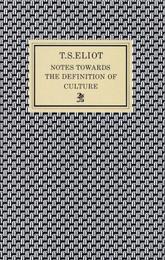
|
Notes Towards the Definition of Culture
Paperback / softback
Main Details
| Title |
Notes Towards the Definition of Culture
|
| Authors and Contributors |
By (author) T. S. Eliot
|
| Physical Properties |
| Format:Paperback / softback | | Pages:128 | | Dimensions(mm): Height 197,Width 126 |
|
| ISBN/Barcode |
9780571063130
|
| Classifications | Dewey:824 |
|---|
| Audience | |
|---|
| Edition |
Main
|
|
Publishing Details |
| Publisher |
Faber & Faber
|
| Imprint |
Faber & Faber
|
| Publication Date |
1 January 1973 |
| Publication Country |
United Kingdom
|
Description
The term culture . . . includes all the characteristic activities and interests of a people; Derby Day, Henley Regatta, Cowes, the twelfth of August, a cup final, the dog races, the pin table, the dart board, Wensleydale cheese, boiled cabbage cut into sections, beetroot in vinegar, 19th century Gothic churches and the music of Elgar. The reader can make his own list . . .'In this famous essay T. S. Eliot examines the principal uses of the word, and the conditions in which culture itself can flourish'So rich in ideas that it is difficult to select two or three of them for comment . . . it is a natural history of culture.' Sunday Times
Author Biography
Thomas Stearns Eliot was born in St Louis, Missouri in 1888. He was educated at Harvard, at the Sorbonne in Paris, and at Merton College, Oxford. His early poetry was profoundly influenced by the French symbolists, especially Baudelaire and Laforgue. In his academic studies he specialised in philosophy and logic. His doctoral thesis was on F. H. Bradley. He settled in England in 1915, the year in which he married Vivienne Haigh-Wood and also met his contemporary Ezra Pound for the first time. After teaching for a year or so he joined Lloyds Bank in the City of London in 1917, the year in which he published his first volume, Prufrock and Other Observations. In 1919 Poems was hand-printed by Leonard and Virginia Woolf. His first collection of essays, The Sacred Wood, appeared in 1920. His most famous work, The Waste Land, was published in 1922, the same year as James Joyce's Ulysses. The poem was included in the first issue of his jou
|